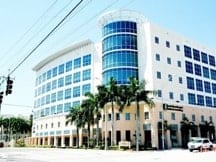Foot Fracture Surgery
What is foot fracture surgery? A foot fracture can range in severity from a thin crack to a shattered or crushed bone. Because we depend so heavily on the intricate coordination of all the delicate bones that make up our heels, ankles, and toes, an injury that might seem minor still needs to be taken seriously. Because elements of the foot operate like an elaborate belt and pulley system, each bone, ligament, and tendon are depended upon to make the whole foot function optimally. The following is a breakdown of the most common ways to refer to various bone fractures:
- Closed fracture:bone does not break through the skin
- Open fracture (or compound fracture):bone protrudes from the skin
- Hairline fracture:a thin crack in the bone
- Single fracture:breakage in one location only
- Segmental fracture:breakage in two locations
- Comminuted fracture:breakage into multiple pieces
- Displaced fracture:breakage into uneven pieces, making realignment difficult
- Non-displaced fracture:breakage into fairly even pieces, making realignment easier
- Greenstick fracture:bone has broken on one side and is bent on the other
- Torus fracture:bone has broken on one side, causing a bump on the other side
Causes: Fractures can be caused by many activities, situations, or incidents:
- Traumais the most common culprit. Fractures from trauma are typically caused by bearing all the weight of a fall on the foot, a vehicular accident, or a sports injury.
- Osteoporosiscan lead to fractures because bones are weakened by this condition and more easily broken by minor stressors.
- Overuseis another cause because when muscles fatigue from overuse, the pressure on the bone may be strong enough to cause a fracture.
Sign & Symptoms: If you have a fractured foot, you may experience some of the following signs and symptoms:
- Immediate, throbbing pain
- Increased pain during activity that decreases with rest
- Swelling
- Bruising
- Tenderness
- Deformity
- Difficulty with walking or bearing weight
Diagnosis and Treatment: Time is of the essence in stabilizing the foot to avoid further injury, more swelling, and internal or external bleeding.
If you think you have fractured your foot, the first step is to immobilize the affected area and seek a doctor or ER for evaluation. While you are in transit, a makeshift splint like a rolled magazine may help keep a fractured foot supported. Keeping your foot raised and gently applying ice is helpful in reducing swelling, making treatment easier. In the ER or primary care office, an X-ray may be ordered, or an MRI if soft tissue damage is suspected. Treatment of fractured bones falls into these broad categories:
- Stabilize/immobilize for self-healing (hairline fractures and some simple fractures can be treated this way)
- Realign bones by manipulationin the case of closed, non-displaced fractures with one and sometimes two fracture sites may be candidates
- Surgically realign bonesin the case of non-displaced fractures
- Surgically realign or repair bones(sometimes with the use of bone grafts) by using hardware such as pins, screws, plates, or wires, temporarily or permanently, to hold bone alignment in place
Recovery: Casts, splinting, and other appliances and aids are used in various combinations to allow fractures and joint dislocations to heal. This usually takes 3-6 weeks, depending on the nature and location of the break, as well as the age and overall health of the patient.
Dr. Ray Lopez
Minimally Invasive Bunion Surgery

- Main Office:
- Miami Beach 400 Arthur
- Godfrey Road Suite #412
- Miami Beach, FL 33140

- South Miami
- 6200 Sunset Drive Suite #402
- South Miami, FL 33143

- Pembroke Pines
- 601 N. Flamingo Road
- Suite #101, Pembroke Pines, FL 33028

- Aventura
- 21000 NE 28th Ave.
- Suite #203, Aventura, FL 33180





